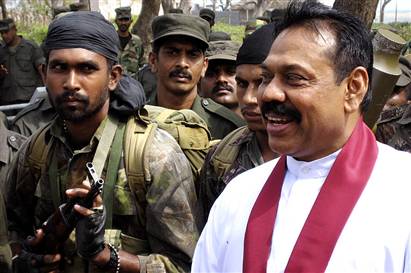Ilankai Tamil Sangam28th Year on the Web Association of Tamils of Sri Lanka in the USA |
|||||
 Home Home Archives Archives |
Rising Tension Over TamilsSri Lanka’s botched tsunami reconstruction efforts are aggravating political violence.by Zvika Krieger, Newsweek, February 9, 2007
Sri Lankan President Mahinda Rajapakse was jubilant. With good reason. His army had just recaptured Vakarai, a northeastern city controlled by the separatist Tamil Tigers for more than a decade. It was a welcome victory for Rajapakse, given that the latest escalation of violence between the government and the rebels has claimed the lives of more than 1,000 people in the past year—and that the 150 fatalities of the last month have made it one of the deadliest since the 2002 ceasefire. "What we have done is to liberate the people from terrorists," Rajapakse gloated, as he mingled with the soldiers that secured Vakarai during a visit there this week. "We have to tame the Tigers." That battle is far from over. Sri Lanka is still struggling to overcome the aftermath of the 2004 Indian Ocean tsunami that killed more than 30,000 Sri Lankans and left hundreds of thousands homeless. Unlike in Indonesia, where the tsunami devastation helped pave the way for a peace deal with the Aceh rebels, Sri Lanka’s reconstruction efforts have only aggravated political violence here. The reason: festering Tamil anger over what it sees as government neglect of the dispossessed in rebel-controlled regions. "The government really missed a golden opportunity to turn this disaster into a push for peace and reconciliation," says J. C. Weliamuna, Sri Lanka's executive director of Transparency International, a global anticorruption group.
Had Rajapakse traveled some 40 miles down the coast from Vakarai, he could have seen the problem at first hand. There, in the resettlement village of Thiraimadu, in the Tamil region of Batticaloa, over 1,000 tsunami victims are packed into tiny tin houses that have begun to corrode and leak from the winter rains. In another coastal refugee camp at Periyanilavanai, even the narrow corridors between shelters house more than 50 people apiece, with thin pieces of wood serving as family partitions. Disease spreads fast in such cramped living conditions, and residents there are currently battling an outbreak of chikungunya flu. Thiraimadu and Periyanilavanai are hardly isolated cases. Despite the billions of dollars in aid that flowed into Sri Lanka after the tsunami, tens of thousands of tsunami survivors have spent more than two years in crowded tent camps or temporary homes. According to U. N. statistics, Tamil regions have received 20 percent less aid than other areas, despite having suffered 65 percent of the tsunami destruction. And as little as 29 percent of the required permanent houses have been completed in the war-torn Tamil regions, compared to 98 percent in the south. A U.N. report released by the organization’s special envoy for tsunami recovery last month criticizes the Sri Lankan government for unequal access to housing grants for Tamils and slower disbursement of funds to Tamil areas. NGOs trying to work in Tamil regions complain that the government has placed onerous restrictions on their operations, ranging from excessive checkpoints to burdensome work-permit requirements. Hard-line Sinhalese members of Sri Lanka’s main ethnic group—have derailed a crucial aid-sharing agreement between the government and rebels, and a presidential decree enacted last month effectively criminalizes any interaction with the Tamil rebels, known as the LTTE. "All aid has come to a complete standstill in the Tamil areas," said a government official from the Tamil city of Jaffna. Rampant government corruption also hasn’t helped: an internal government investigation by the Sri Lankan Auditor-General uncovered the disappearance of millions of dollars of aid money into "General Deposit Accounts without being used for the intended purposes" and other "blatant violations" of the law by government agents. "[The government] did not have the capacity to discriminate between the reliable and the unreliable, the trustworthy and the fugitive, and the truthful and the deceitful," admitted Shanti Fernando, head of the government's Reconstruction and Development Agency, in an opinion piece in a state-owned newspaper last month. Tamil leaders claim that the government, run by the nationalist People's Alliance coalition, is intentionally ignoring Tamil victims. "The disparity between reconstruction in the south, as compared to the northeast, is striking," says Arjunan Ethirveerasingam, project manager for the Tamil Reconstruction Organization. "The facts on the ground show an ulterior motive—that the government is using food and medicine as a weapon in their war against the Tamils." Many observers claim that the government is actively clearing NGOs from the area to make way for their counter-insurgency campaign. "They don't want busybodies there to report on abuses and casualties," says Bhavani Fonseka, a researcher at the Sri Lankan Centre for Policy Alternatives. "NGOs are a nuisance, and the government wants complete freedom to carry out its plans in the Tamil areas." Government officials say their restrictions are justified by security fears—and that the communication and construction equipment of the NGOs could be used by the rebels against government forces. "The LTTE is a war machine," says Col. R. Hariharan, an Indian specialist in counterinsurgency who served in Sri Lanka with a peacekeeping force created by the Indo-Sri Lanka peace accord. "Any sensible U.S. commander in Iraq would be doing the same thing as the Sri Lankan government." Government officials also argue that the LTTE itself has been undermining reconstruction efforts by imposing taxes and other restrictions within their territory. The separatists, for their part, are using the deteriorating conditions in Tamil areas to bolster their claims that only an independent Tamil state can care for the region’s ethnic minority. Both sides may have some legitimate concerns. But for the dispossessed in the camps, there is little relief in sight.
| ||||
